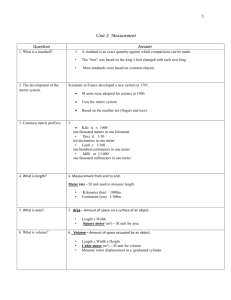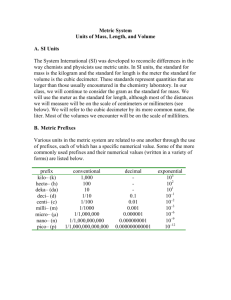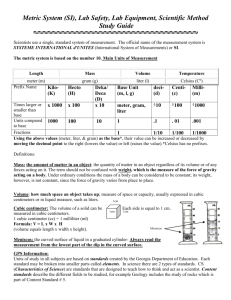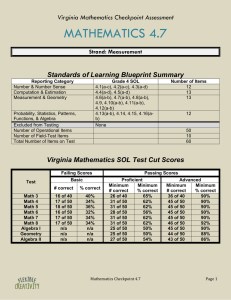Units of Measurement Commonly Used in Agriculture
advertisement
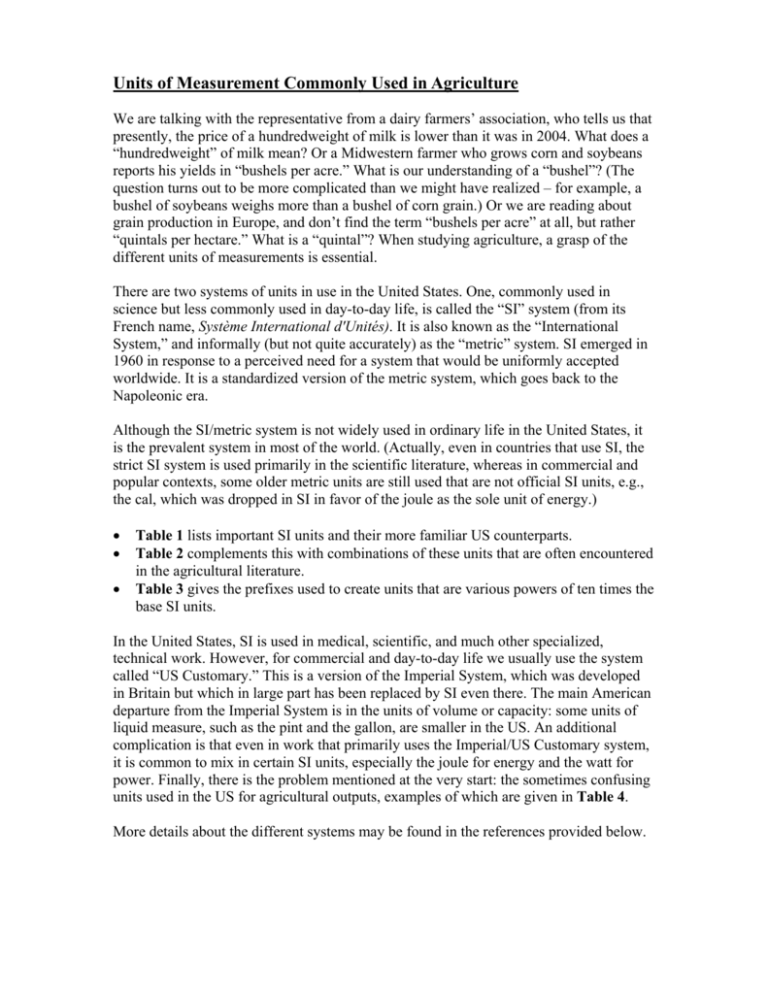
Units of Measurement Commonly Used in Agriculture We are talking with the representative from a dairy farmers’ association, who tells us that presently, the price of a hundredweight of milk is lower than it was in 2004. What does a “hundredweight” of milk mean? Or a Midwestern farmer who grows corn and soybeans reports his yields in “bushels per acre.” What is our understanding of a “bushel”? (The question turns out to be more complicated than we might have realized – for example, a bushel of soybeans weighs more than a bushel of corn grain.) Or we are reading about grain production in Europe, and don’t find the term “bushels per acre” at all, but rather “quintals per hectare.” What is a “quintal”? When studying agriculture, a grasp of the different units of measurements is essential. There are two systems of units in use in the United States. One, commonly used in science but less commonly used in day-to-day life, is called the “SI” system (from its French name, Système International d'Unités). It is also known as the “International System,” and informally (but not quite accurately) as the “metric” system. SI emerged in 1960 in response to a perceived need for a system that would be uniformly accepted worldwide. It is a standardized version of the metric system, which goes back to the Napoleonic era. Although the SI/metric system is not widely used in ordinary life in the United States, it is the prevalent system in most of the world. (Actually, even in countries that use SI, the strict SI system is used primarily in the scientific literature, whereas in commercial and popular contexts, some older metric units are still used that are not official SI units, e.g., the cal, which was dropped in SI in favor of the joule as the sole unit of energy.) • • • Table 1 lists important SI units and their more familiar US counterparts. Table 2 complements this with combinations of these units that are often encountered in the agricultural literature. Table 3 gives the prefixes used to create units that are various powers of ten times the base SI units. In the United States, SI is used in medical, scientific, and much other specialized, technical work. However, for commercial and day-to-day life we usually use the system called “US Customary.” This is a version of the Imperial System, which was developed in Britain but which in large part has been replaced by SI even there. The main American departure from the Imperial System is in the units of volume or capacity: some units of liquid measure, such as the pint and the gallon, are smaller in the US. An additional complication is that even in work that primarily uses the Imperial/US Customary system, it is common to mix in certain SI units, especially the joule for energy and the watt for power. Finally, there is the problem mentioned at the very start: the sometimes confusing units used in the US for agricultural outputs, examples of which are given in Table 4. More details about the different systems may be found in the references provided below. Table 1. Common SI units, and their corresponding US Customary counterparts. SI/Metric Length Comparable Imperial/US Customary Units foot (ft)= 0.3048 m yard (yd) = 0.9144 m meter (m) centimeter (cm) = 10-2 m 3 Area kilometer (km) = 10 m mile (mi) = 1.609 km square meter (m2 ) square foot (ft2) = 0.0929 m2 square yard (yd2) = 0.8361 m2 square inch (in2) = 6.452 cm2 square centimeter (cm2) = 10-4 m2 hectare (ha) = 104 m2 Volume inch (in) = 2.54 cm square kilometer (km2) = 106 m2 = 100 ha liter (l or L) cubic centimeter (cm3 ) = 1 milliliter (ml) cubic meter (m3) = 103 l acre (A or ac) = 43,560 ft2 = 0.4047 ha. square mile (mi2) = 640 A = 2.590 km2 gallon (gal) = 3.785 l cubic foot (ft3) = 7.476 gal = 28.32 l cubic inch (in3) = 16.39 cm3 cubic yard (yd3) = 0.7645 m3 Temperaturea degrees Celsius (°C) degrees Fahrenheit (°F) = 9/5 (° C) + 32 Massb kilogram (kg) pound (lb) = 0.4536 kg -3 gram (g) = 10 kg ounce (oz) = 1/16 lb = 28.35 g metric tonne or metric ton (t) = 103kg short ton (commonly called “ton”) = 2000 lb = 0.9071 t long ton = 2240 lb = 1.016 t hundredweight (cwt) = 100 lb = 0.4536 q pound (lb) = 4.448 N quintal (q) = 102 kg Force/weightb newton (N) Pressure pascal (Pa) = 1 N/m2 Energyc kilopascal (kPa) = 103 Pa pounds per square inch (psi) = 6.893 Pa torricelli (torr) = 1 mm of mercury (mm Hg) = 0.1333 kPa 1 bar = 105 kPa inches of mercury (in Hg) = 25.4 mm Hg = 0.491 psi atmosphere (atm) = 1.013 bar joule (J) foot-pound (ft-lb) = 1.356 J calorie (cal) = 4.187 J Power kilocalorie (kcal or Cal) = 103 cal watt (W) = joules per second (J/s) kilowatt (kW) = 103 W British thermal unit (Btu) = 1055 J = 0.252 kcal horsepower (hp) = 0.7457 kW a The official way to express temperature in SI is in Kelvin (K). However, in agriculture, temperature is expressed as either Celsius or Fahrenheit. b In a scientific context, the pound (lb) is a unit of weight or force, but in commercial usage it is commonly taken as unit of mass, with the indicated equivalence to the kg (a true unit of mass). c Several SI/metric units of energy and power are commonly used with the Imperial/Customary US system, e.g. W, kWh, J, and kcal (for food energy). Table 2. Additional units customarily used in agricultural research or practice Quantity SI Imperial/US Customary -10 Wavelength Irradiance angstrom (Å) = 10 m nanometer (nm) = 10-9 m watts per square meter (W/m2) Volume of irrigation water hectare-meter (ha-m) Fertilizer and pesticide application rates Electrical energy Electrical conductivity kilograms per hectare (kg/ha) Suspended sediment concentration Dissolved salts Cation exchange capacity Soil reaction kilowatt-hour (kWh) = 3.6x106 J siemen (S) = mhos per centimeter (mho/cm) decisiemens per meter (dS/m) millimhos per centimeter (mmho/cm) = 1 millisiemen (mS) kilograms per cubic meter (kg/m3) milligrams per cubic meter (mg/m3) milliequivalents per 100 grams of soil (meq/100 g) pH acre-foot (ac-ft) = 0.1233 ha-m pounds per acre (lb/A or lb/ac) = 0.892 kg/ha See note c to Table 1. Micron (or micrometer) (µ) = 10-6 m Particle size Table 3. Multiples of SI base units Several prefixes are used with the base units in the SI system to derive other units that are greater or less than the base units by various powers of 10. The following table illustrates their usage with the meter, the base unit of length in the SI system. Multiple 100 101 102 103 Name meter decameter hectometer kilometer Symbol m dam hm km Multiple Name Symbol 10-1 10-2 10-3 decimeter centimeter millimeter Dm Cm Mm 106 109 1012 1015 megameter gigameter terameter petameter Mm Gm Tm Pm 10-6 10-9 10-12 10-15 micrometer nanometer picometer femtometer µm Nm Pm Fm Table 4. US units of agricultural output Unit Value a Bushel corn, sorghum, rye soybean, wheat 56 lb 60 lb Barley 48 lb Oats 32 lb Bale of cotton 500 lb Hundredweight (cwt) of milk 100 lb or 11.63 gal A more complete list of these units can be found at http://muextension.missouri.edu/xplor/agguides/crops/g04020.htm a The bushel was originally a unit of volume. However, for grains it has long been defined in terms of weight; the definition varies among different grains because of their differing densities. Web-based aids for conversion of units: Diver, S (2003). Measurements, conversion units and calculations useful to farmers and Agricultural Specialists. ATTRA- National Sustainable Agriculture Information Service, http://www.attra.org/attra-rl/measurements.html#Quick http://www.wikipedia.org A Dictionary of Measures, Units and Conversions Centre for Innovation in Mathematics Teaching, University of Exeter http://www.ex.ac.uk/cimt/dictunit/dictunit.htm Tables for weights and measurements: Crops. Extension Department of the University of Missouri. http://muextension.missouri.edu/xplor/agguides/crops/g04020.htm US Cotton Bale Dimensions. National Cotton Council of America. http://www.cotton.org/tech/bale/bale-description.cfm
